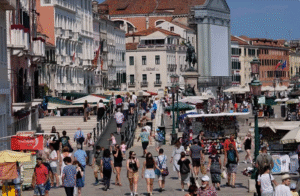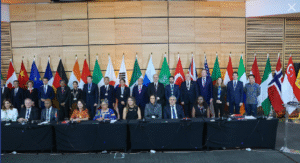Europe gears up for tourists

AFP bureaus in Europe — European tourism has had its worst time in living memory as coronavirus lockdowns, curfews and hotel and restaurant closures have threatened the industry’s livelihood and frustrated travellers eager for a change of scenery.
The summer of 2020 saw a sharp downturn in European cross-border travel, leaving the continent’s beaches, cities and monuments – many of them top global destinations – eerily deserted.
This year is to be different: Covid-19 is still far from defeated, but virus testing is widely available, the EU countries’ vaccination rollout has gathered pace and the bloc is only days away from launching an EU travel pass, in digital and paper form, assembling key health information to speed up processing at arrival points.
Some key destinations, like Italy, are already reporting brisk bookings, while Spain hopes to reach up to 70 percent of pre-pandemic tourism levels.
Tourists from countries outside the bloc -which since Brexit include the United Kingdom – still face plenty of obstacles at EU borders, and mandatory social distancing and mask-wearing will dampen everyone’s experience.
But governments say they must avoid a dreaded fourth coronavirus wave, even as they throw tourism a lifeline.
“We have to reconcile freedom of mobility with the need for security,” French Tourism Minister Jean-Baptiste Lemoyne said, echoing the sentiment across the bloc.
Here is a summary of rules in some of Europe’s key tourism spots.
France –
France, the world’s top tourist destination, announced a colour-coded map laying out entry protocols for the summer travel season, with restrictions lifted for EU residents and “green” countries Australia, South Korea, Israel, Japan, Lebanon, New Zealand and Singapore.
From July 1, France will also recognise the European health pass.
In “orange” zones including Britain, North America and most of Asia and Africa, even vaccinated travellers to France will still have to produce a recent negative Covid test, but they will no longer need to quarantine or have a compelling reason for their visit.
For non-vaccinated people coming from “orange” zones, however, only essential trips will be allowed and a seven-day self-quarantine imposed.
Sixteen countries will remain largely off-limits, including India, Turkey, South Africa and much of South America, including Brazil.
Mask-wearing remains mandatory indoors and outdoors, but curfew rules will be lifted on June 30.
Spain –
On June 7 Spain dropped the requirement for EU arrivals to produce a recent negative PCR test. Now anyone who has been vaccinated can enter the country, irrespective of their point of origin.
Masks remain mandatory, including outdoors, except on beaches as long as people keep a distance of at least 1.5 metres (5 feet) from each other. Walking on the beach will still require a mask.
Both the Madrid region and Catalonia, which includes hotspot Barcelona, have lifted their curfews and bars and restaurants can open until 1:00 am in Madrid and until midnight in Catalonia.
Spain is “technically ready” for the EU health pass, but hasn’t linked up with the system yet.
Italy –
Arrivals from the EU, Britain and Israel must produce a negative Covid test less than 48 hours old and fill in a health form, but don’t need to go into quarantine.
Travellers from Australia, South Korea, Rwanda, Thailand, Canada and the US need to show a negative test, go into quarantine for 10 days, and then take another test.
Italy is off-limits for tourists from Brazil, India, Bangladesh and Sri Lanka.
Masks are still mandatory, although from July people may be allowed to take off the protection when outside
A curfew between midnight at 5am remains in force, and no more than four people per table are allowed in bars and restaurants.
Portugal –
Portugal’s southern Algarve coast is a favourite destination for tourists from Britain, with bookings having picked up since the country reopened to European tourists last month.
All arrivals from EU countries, the Schengen area and the UK need a negative PCR test less than 72 hours old to enter Portugal.
The same rules apply to arrivals from Australia, South Korea, Israel, New Zealand, Rwanda, Singapore, Thailand and China.
Everyone else needs a compelling reason to enter Portugal.
Arrivals from South Africa, Brazil and India will have to self-isolate on arrival.
Social distancing and mask-wearing are mandatory, and special rules are in place for beaches and swimming pool areas, with a distance of three metres minimum required between parasols.
Portugal is expected to sign up to the health pass scheme on July 1.
Greece –
The Greek government is hoping to to reach about half of its pre-pandemic tourism revenues this summer which, if confirmed, would double last year’s figure.
Arrivals from EU countries and the Schengen area are authorised to enter Greece, as are residents of Canada, the US, Israel, China, Thailand, Russia and Saudi Arabia.
But they are required to fill in a form and produce proof of vaccination or a PCR test of less than 72 hours, or a certificate of post-infection immunity.
Masks remain mandatory both indoors and outdoors.
Discotheques and indoor cultural venues remain shut, while the maximum number of people allowed per table in restaurants is six.
United Kingdom –
Travel to Britain is made difficult for most of the world by strict curbs on arrivals, costly quarantine requirements and expensive Covid tests.
The tourism sector’s efforts are mostly focused on domestic holidaymakers.
Travellers from a handful of “green” countries — including Australia, New Zealand and Iceland — need only produce a negative Covid test.
Arrivals from Ireland, the Isle of Man and the Channel Islands can enter freely.
7 June , 2021
Image : Tourists in Paris . Photo: AFP














